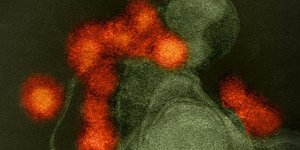| News / Science News |
Rosetta Comet May Be a Contact Binary
NASA | JULY 20, 2014
The European Space Agency's Rosetta probe is approaching Comet 67P/Churyumov-Gerasimenko for a historic mission to orbit and land on the comet's nucleus. As Rosetta approaches the comet (now less than 9,000 km away), the form of the nucleus is coming into focus, and it is extraordinary.

Comet 67P/C-G on 14 July 2014 - processed view. Credits: ESA/Rosetta/MPS for OSIRIS Team MPS/UPD/LAM/IAA/SSO/INTA/UPM/DA
This week's images of comet 67P/Churyumov-Gerasimenko reveal an irregular shape. There were hints of that in last week's images and in the unscheduled previews that were seen a few days ago, and in that short time it has become clear that this is no ordinary comet. Like its name, it seems that comet 67P/C-G is in two parts.
What the spacecraft is actually seeing is the pixelated image shown at right, which was taken by Rosetta's OSIRIS narrow angle camera on 14 July from a distance of 12,000 km.
A second image and a movie show the comet after the image has been processed. The technique used, called "sub-sampling by interpolation", only acts to remove the pixelisation and make a smoother image, and it is important to note that the comet's surface features won't be as smooth as the processing implies. The surface texture has yet to be resolved simply because we are still too far away; any apparent brighter or darker regions may turn out to be false interpretations at this early stage.
But the movie, which uses a sequence of 36 interpolated images each separated by 20 minutes, certainly provides a truly stunning 360-degree preview of the overall complex shape of the comet. Regardless of surface texture, we can certainly see an irregular shaped world shining through. Indeed, some people have already likened the shape to a duck, with a distinct body and head.
Although less obvious in the 'real' image, the movie of interpolated images supports the presence of two definite components. One segment seems to be rather elongated, while the other appears more bulbous.
Dual objects like this – known as 'contact binaries' in comet and asteroid terminology – are not uncommon.
One popular theory is that such an object could arise when two comets – even two compositionally distinct comets – melded together under a low velocity collision during the Solar System's formation billions of years ago, when small building blocks of rocky and icy debris coalesced to eventually create planets. Perhaps comet 67P/C-G will provide a unique record of the physical processes of accretion.
Or maybe it is the other way around – that is, a single comet could be tugged into a curious shape by the strong gravitational pull of a large object like Jupiter or the Sun; after all, comets are rubble piles with weak internal strength as directly witnessed in the fragmentation of comet Shoemaker-Levy 9 and the subsequent impacts into Jupiter, 20 years ago this week. Perhaps the two parts of comet 67P/C-G will one day separate completely.
On the other hand, perhaps comet 67P/C-G may have once been a much rounder object that became highly asymmetric thanks to ice evaporation. This could have happened when the comet first entered the Solar System from the Kuiper Belt, or on subsequent orbits around the Sun.
YOU MAY ALSO LIKE



